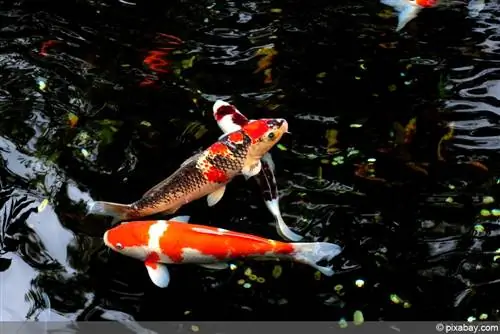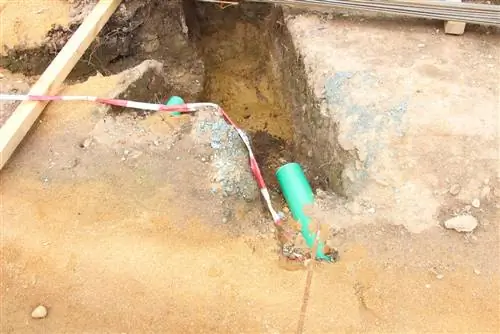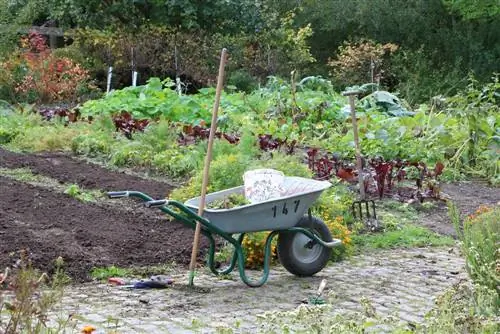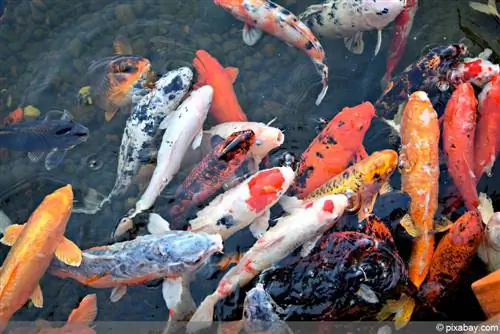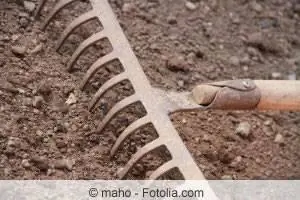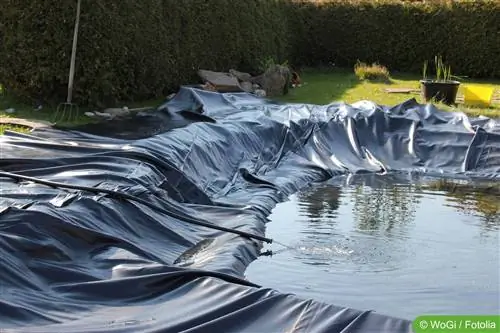- Author admin [email protected].
- Public 2023-12-17 03:39.
- Last modified 2025-01-24 12:45.
If you want to create a koi pond in your garden, you can't avoid careful planning. In order to keep the noble ornamental fish as species-appropriate as possible, the pond must meet certain requirements. In addition, koi are relatively demanding, which is why the pond requires a certain amount of basic equipment. You can find out here what you need to consider when setting up a koi pond and what costs you can expect!
Location
The noble ornamental fish have certain requirements for their habitat, so the choice of location is an important factor when creating a pond. First of all, it should be taken into account that the koi need both shady and sunny places. Ideally, the pond will be one third in shade and two thirds in full sun. When choosing a location, the following aspects should also be taken into account:
- Positioning devices
- Placement of external sockets for devices
- 3m minimum distance between pond and power connection
- Minimum distance to neighboring property
- Planting around the pond
- Seating options, walkways, etc.
- Fuse
Note:
Securing the pond makes sense, especially with children! If a child falls into the pond and injures themselves, the pond owner is liable.
Shadow Provider
Various plants can be used to provide shade in your home garden, although deciduous trees are not recommended. The falling leaves in autumn not only pollute the pond, but also create additional workload. Instead, bamboo plants as well as cinchona grass or conifers should be grown in the immediate vicinity of the pond. Alternatively, the following aids and constructions are also suitable as shade providers:
- Sun sail
- bridge
- Bridge
Tip:
An integrated waterfall not only provides a visual highlight, but also creates a turbulent water surface. This refracts the sun's rays, which is why the light comes in at a different angle.
Materials and shape
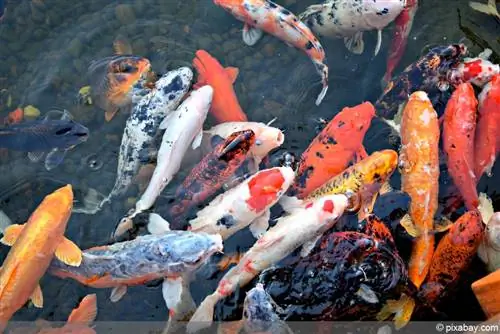
The shape of the pond is basically up to the taste of the pond owner, although a round or oval shape is always preferable to a square one. On the one hand, sharp or pointed edges pose a risk of injury to the fish and, on the other hand, dirt can accumulate in the corners. However, which material the pond is best made of depends primarily on the composition of the soil. The following materials are suitable for the koi pond:
Concrete pond
- suitable for sandy soils
- Advantages: simple and robust, freely designable
- easy to clean
- Disadvantages: Pond edge must be concealed
- Costs for the specialist company
Foil pond
- Soils made of clay or loam are suitable
- Advantage: Relatively cheap and flexible
- Disadvantage: prone to damage
- Wrinkling in the foil
- dirt can collect in it
Glass Reinforced Plastic
- Advantage: extremely durable and stable
- corrosion-resistant and insulating
- Disadvantage: relatively expensive
Size of the pond
The size of the pond is crucial for the well-being of the koi, because the koi need enough space to live appropriately for their species. It is also important to take into account that the koi are always kept in groups of at least 5. The size of the pond is therefore directly dependent on the fish population, whereby the following guidelines generally apply:
- at least 1,000 liters of water volume per koi
- optimal 3,000 -5,000 liters of water volume per koi
- each additional koi requires an additional 1,000 liters
- 10 koi need around 15,000 liters
- Koi pond at least 10-30 m³ volume
Note:
A building permit is required from a certain pond size!
Depth of the pond
The pond represents the optimal habitat for the koi if it has both deep and shallow areas. The koi need a certain depth in order to be able to overwinter in the lower water layers. The shallow areas, on the other hand, are needed by the females for spawning. If the females have no opportunity to lay eggs, they break down the eggs again, which can sometimes make them sick. It is therefore important that the koi pond is not only appropriately large, but also deep:
- Minimum depth: 1.5-2.0m
- deeper than 2, 5 not advisable
- Fish are otherwise difficult to catch
Devices
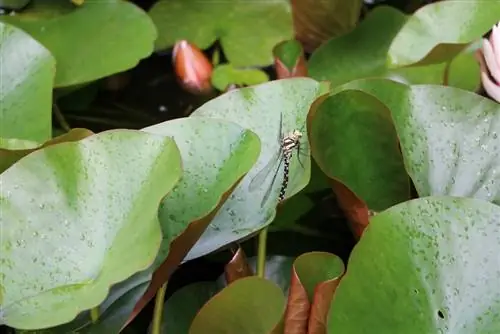
To always ensure excellent water quality, it is advisable to equip the pond with some mechanical devices. These not only clean the water of rubbish and pollution, but also enrich it with vital oxygen. Of course, not all devices are an absolute must, but they help immensely to keep the climate inside the koi pond stable at all times. In particular, a high-quality filter system is considered essential for many koi owners and is therefore strictly recommended.
Filter
A filter is almost essential in the koi pond, because the noble ornamental fish eat comparatively a lot. This in turn increases the amount of excretions, which naturally pollute the water. However, the compromised water quality affects the he alth of the fish and poses a huge danger to them. In order to always ensure the cleanliness of the water, it is usually necessary to install a filter. There are different models, with the following being the most suitable:
Chamber filter
- mechanical and biological filtering
- Advantages: Cost-effective and flexible
- Disadvantages: needs to be cleaned often, takes up a lot of space
- filters the water in up to 5 different chambers
- Costs: from approx. 400 euros
Beadfilter
- biological filtering
- Advantages: powerful and space-saving
- Disadvantages: relatively expensive, energy-intensive
- Filter chamber filled with tiny plastic balls (beads)
- Costs: from approx. 600 euros
Module filter
- works like chamber filter
- Advantages: adaptable and expandable
- disadvantages: must be cleaned manually
- Free-standing chambers can be added or removed
- Costs: from approx. 600 euros
trickle filter
- enriches water with oxygen
- Advantage: cost-effective and space-saving
- Disadvantage: difficult to integrate visually, relatively loud
- Costs: from approx. 200 euros
Drum filter
- mechanical cleaning
- Advantage: particularly effective, quiet and low-maintenance
- Disadvantage: high acquisition costs, large space requirement
- Costs: from approx. 1,000 euros
Other equipment
In addition to the filter, a powerful pond pump is also essential. The pump sucks in the water, passes it on to the filter and then returns it to the pond. When purchasing a pump, however, it is important to ensure that the manufacturer's information usually refers to ponds with no or only a small number of fish. To ensure that the pump is suitable for the planned pond size, the information should always be halved or divided into thirds. If the basic elements are available, the pond can be equipped with the following devices:
- UVC device: Keeps the number of germs low
- Diaphragm pump: Provides additional oxygen supply
- Pond sludge vacuum: Removes mud from the pond bottom
- Skimmer: keeps the water surface clean
Tip:
Equipped with different devices is advisable, but not absolutely necessary. Especially in ponds with low fish populations, it is possible to ensure water quality and oxygen supply with sufficient planting.
Planting
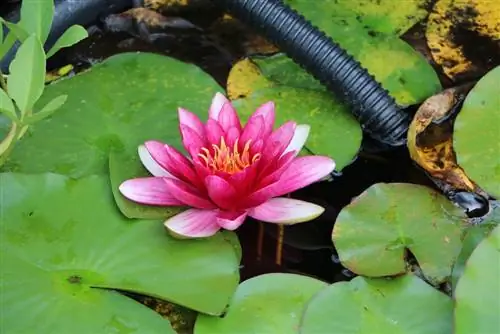
When planting koi ponds, it is important to take into account that the ornamental fish will tamper with and nibble on most of the plants. For the koi pond, separate plant zones, such as a small stream with bank plants, have proven particularly useful. Alternatively, so-called plant islands are also available: These float around freely on the surface of the water and are provided with a protective net underneath and are therefore protected from the koi. If you would like to plant additional plants in the pond, you should preferably choose the following plants:
- Water Lilies
- Hornblatt
- Bulbs
Costs
The acquisition costs of a koi pond vary greatly and therefore cannot be generalized. On the one hand, it is possible to create the pond yourself and, on the other hand, this can be done by a specialist company. When building it yourself, only the material costs are incurred, whereas most specialist companies offer a price per 1,000 liters of water volume. A professionally carried out pond planning can therefore cost several thousand euros to the budget. In addition to the one-off acquisition costs, the ongoing fixed costs should also be taken into account:
- Minimum volume 10,000 liters
- from 30,000 liters: fixed costs x3
- from 60,000 liters: fixed costs x9
- Electricity costs: 30-150 euros/month
- Water costs: 10-50 euros/month
- Food: 10-50 euros/month

